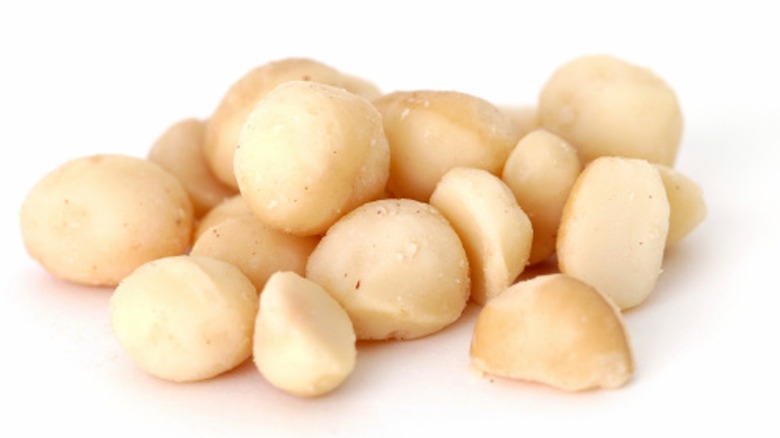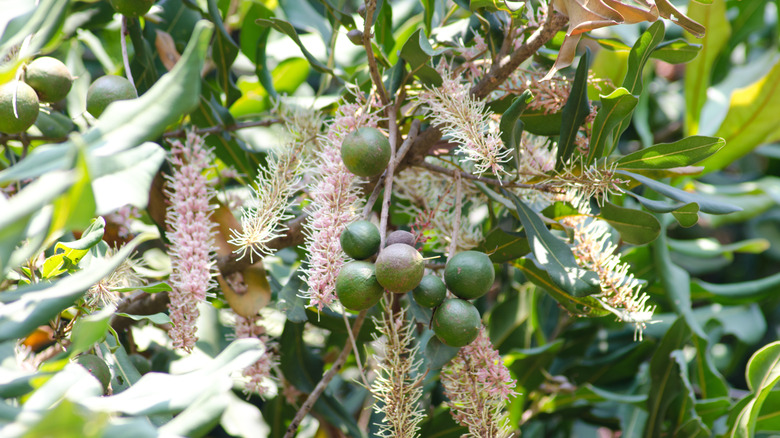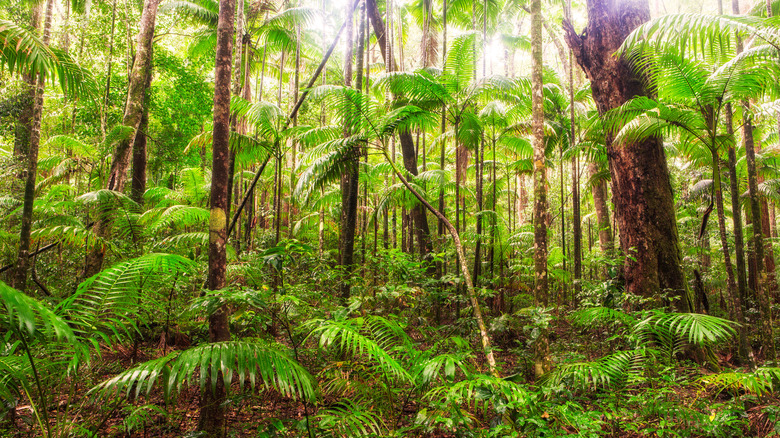The Reason Macadamia Nuts Are So Expensive
Macadamia nuts have been celebrated by cooks and chefs for their rich creaminess that works great in baking sweet dishes and making sauces, as well as the texture and crunch that they add to savory meals. What they haven't been celebrated for is their high cost. Consistently ranked as one of the most expensive nuts at $25 per pound, Macadamia nuts are a prized delicacy, and with a one-ounce serving, or 10-12 nuts, containing around 200 calories, you may want to think twice before eating Macadamia nuts in large quantities.
But like most nuts that you should be eating, moderation is the key to garnering all their nutritious aspects, of which there are numerous. They contain flavonoids and tocotrienols, a type of vitamin E, which are believed to help prevent or fight cancer. They also contain manganese and B Vitamin thiamin. And while a one-ounce serving provides about 21 grams of fat, nearly 80% of that is monounsaturated fat (MUFAs). MUFAs are associated with cardiovascular and heart health and also help diabetics control their blood sugar. There is also evidence that Macadamia nuts help in lowering cholesterol.
So what makes the Macadamia nut so pricey? A big part of it concerns the lack of Macadamia tree varieties that produce good-quality nuts and the lengthy amount of time a tree begins producing nuts. But another important aspect to remember is that Macadamia nuts have a long history but weren't commercially produced until 100 years ago.
Only two species produce good quality nuts
Macadamia consists of four species belonging to the Proteaceae family: Macadamia integrifolia, Macadamia teteraphylla, Macadamia ternifolia, and Macadamia jansenii. Of these, M. integrifolia and M. teteraphylla are the only two that produce the nuts that are grown and sold commercially. The nuts of the M. ternifolia are very small and bitter and are also referred to as Gympie nuts. The endangered M. jansenii is only found in the Bulburin National Park in Queensland, Australia, and also produces very small and bitter nuts.
M. integrifolia and M. ternifolia are both considered drought-resistant and hardy, but their main enemy is wind. For this reason, a barrier of trees is usually planted around them. The main difficulty with macadamia nuts is the slow seed growth, which begins in 6-7 years for juvenile trees, and another three years before the seeds are mature enough to remove to eat. They then produce good quality nuts for 40-50 years.
Macadamia shells are the most difficult nut to open, requiring 300 pounds of pressure to open. For this reason, it is impossible to know for sure if the nut is ripe enough yet. This means that the nuts typically have to be gone through by hand when harvesting, which can be time-consuming and expensive. Due to the extended time it takes for a Macadamia tree to produce edible nuts and the difficulties with harvesting, macadamia nut production hasn't kept up with demand, keeping prices high.
The Macadamia nut's history
Macadamia nuts originated in Fraser Island, Queensland, Australia, around 60 million years ago. The indigenous people would take the nuts off the macadamia tree. Even they considered the nut special, gifting it during special ceremonies and using it to trade with other tribes.
In 1857, horticulturist Walter Hill and botanist Baron Sir Ferdinand Jakob Heinrich von Mueller noticed the beautiful evergreen trees with swaths of white, pink, and purple flowers. They collected the nuts along the Pine River in Brisbane. Mueller named the tree after his friend, chemist Dr. John Macadam.
William Herbert Purvis is credited with bringing the macadamia nut to Hawaii in 1881, but he didn't stick around to see any money from the introduction. Purvis, who managed the Pacific Sugar Mill with his cousin, married his high school sweetheart and returned to Scotland.
Brothers Edward Walter and Robert Alfred Jordan brought the next batch of macadamia seeds to Hawaii in 1892. It's believed that Jordan, who had connections to Queensland through his wife, sent the seeds to Walter in Hawaii before joining him.
Forty years later, Ernest Sheldon Von Tassel tasted the nuts for the first time, and by 1925 he'd planted seeds from Jordan and Purvis' macadamia trees on 75 acres of land. Walter Pierre Naquin began planting macadamia trees from Purvis' seeds in 1925. Today, the world's largest macadamia nut manufacturer is the Hawaiian-based Mauna Loa Macadamia Nut Corporation, which processes 180,000 pounds of macadamia nuts per day


